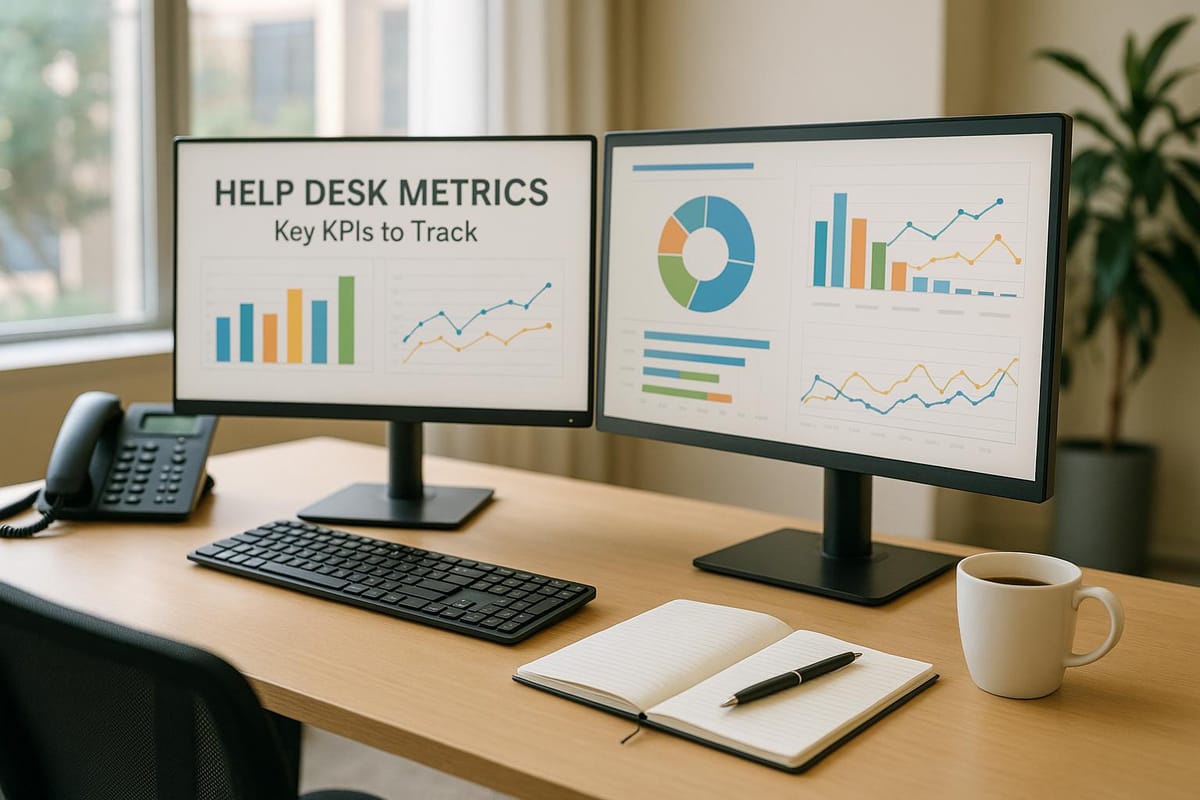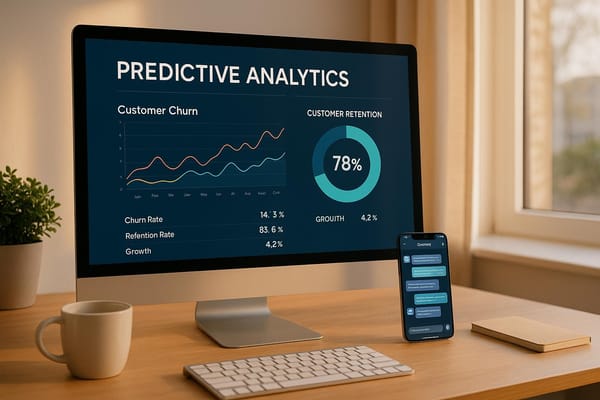Help Desk Metrics: Key KPIs to Track
Explore key help desk metrics and tracking methods to enhance customer support efficiency, accuracy, and decision-making processes.

- Automated Platform Tracking: Uses tools for real-time insights into response times, resolution rates, and customer satisfaction.
- Spreadsheet-Based Tracking: A manual approach for small teams, offering flexibility but requiring more effort and prone to errors.
- Live Dashboard Monitoring: Provides real-time data visualization, helping teams make quick decisions and prevent issues.
Quick Comparison
| Feature | Automated Platform | Spreadsheet-Based | Live Dashboard |
|---|---|---|---|
| Data Accuracy | Very High | Moderate | Very High |
| Update Speed | Real-time | Manual | Real-time |
| Setup Cost | Moderate | Low | Higher |
| Scalability | High | Low | High |
For growing businesses, automated tools like HelpJam offer the best balance of accuracy, efficiency, and scalability. Smaller teams may start with spreadsheets, while large teams benefit from live dashboards for advanced tracking.
1. Automated Platform Tracking
Automated platform tracking simplifies the way help desks monitor metrics by leveraging technology to gather, process, and display live data. This section focuses on how automation improves the tracking of key performance indicators (KPIs).
Modern help desk platforms come equipped with analytics dashboards that automatically track essential KPIs. For instance, HelpJam continuously monitors critical metrics, ensuring data is collected consistently during customer interactions.
Here are some major advantages of real-time automated tracking:
Instant Performance Insights
With metrics updating live as new conversations occur, teams can monitor support operations in real-time. This immediate feedback helps managers quickly identify and resolve bottlenecks, preventing issues from affecting customer satisfaction.
Improved Team Coordination
Features like unified inboxes and live assignment tracking ensure better coordination. Support agents can monitor their own performance, while managers get a clear view of team-wide KPIs.
Data-Driven Decisions
Automated platforms track a variety of metrics, including:
- Response time trends
- Resolution rates
- Customer satisfaction scores
- Team workload distribution
AI-powered tools add even more value by analyzing conversation content, categorizing issues, and tracking resolution efficiency. This reduces the need for manual oversight and ensures smoother operations.
Additionally, detailed customer profiles created through automated interaction tracking allow teams to provide more tailored support experiences.
For businesses experiencing growth, automated tracking scales effortlessly. Platforms like HelpJam can manage high volumes of interactions without compromising on accuracy, making them ideal for small to medium-sized businesses handling increasing customer demands.
| Key Automated Metrics | Tracking Frequency | Business Impact |
|---|---|---|
| Response Times | Real-time | Improves customer satisfaction |
| Resolution Rates | Continuous | Boosts operational efficiency |
| Customer Satisfaction | Immediate | Enhances service quality |
| Team Performance | Live Updates | Optimizes resource allocation |
To get the most out of automated tracking, support teams should:
- Set up real-time alerts for critical KPIs
- Regularly analyze data through dashboards
- Use AI insights to anticipate and address issues
- Integrate tracking tools with other reporting systems
This automated system provides a solid starting point before diving into other tracking methods.
2. Spreadsheet-Based Tracking
Spreadsheets can be a handy tool for smaller teams looking to track help desk metrics in a personalized way. While automated systems are often the go-to, some support teams still prefer spreadsheets for their flexibility in tracking custom KPIs.
Key Components of a Help Desk Spreadsheet
A well-structured spreadsheet for tracking metrics should include:
- Columns for ticket creation and resolution times
- Customer details
- Categories for different types of issues
- Fields to track response times
- Resolution statuses
- Assigned agents
- Customer satisfaction scores
Tips for Managing Manual Tracking
To keep things organized and manageable, use separate worksheets for daily, weekly, and monthly data. This approach ensures that your data remains structured and easy to analyze.
| Metric Category | Required Fields | Update Frequency |
|---|---|---|
| Response Times | First Response, Resolution Time | Daily |
| Ticket Volume | New, Resolved, Backlog | Weekly |
| Agent Performance | Tickets Handled, Resolution Rate | Weekly |
| Customer Feedback | CSAT Score, Comments | Per Interaction |
Ensuring Data Accuracy
To maintain accuracy, use tools like dropdown menus, data validation rules, and conditional formatting. Automating calculations and creating regular backups can also help reduce errors.
Challenges with Manual Tracking
Spreadsheets can struggle to keep up with high ticket volumes. As the workload increases, so does the chance for human error, making manual tracking less reliable for larger teams.
Combining Spreadsheets with Automated Tools
Spreadsheets work best when paired with modern help desk platforms. For instance, you can export data from automated systems into spreadsheets for deeper analysis. This approach allows for more detailed tracking without sacrificing accuracy. Standardizing calculation formulas in your spreadsheets can also improve consistency.
Sample Formulas
Here are a few formulas to simplify tracking metrics:
- Average Response Time: (Resolution Time - Creation Time) / Total Tickets
- First Response Time: First Reply Time - Ticket Creation Time
- Resolution Rate: (Resolved Tickets / Total Tickets) × 100
While spreadsheets can be customized to meet specific needs, growing teams often benefit from transitioning to more dynamic tools like live dashboards for real-time tracking and insights.
3. Live Dashboard Monitoring
Live dashboards provide real-time updates, helping teams make quick and informed decisions. They dynamically display key metrics with easy-to-understand visuals, making it simple to spot trends or issues as they happen. By continuously tracking important data, teams can stay on top of critical factors and respond quickly to customer needs.
Key Real-Time Metrics
For help desk operations, live dashboards focus on these essential metrics:
| Metric Category | Key Data Points | Update Frequency |
|---|---|---|
| Conversation Analytics | Active Conversations, Conversation History | Real-Time |
| Response Metrics | First Response Time, Resolution Rates | Real-Time |
| Customer Satisfaction | CSAT Trends | Real-Time |
These metrics allow teams to monitor performance in real-time and make adjustments as needed.
Monitoring and Adjusting Performance
HelpJam's analytics tools provide instant insights into performance metrics. Real-time tracking of conversations, response times, and resolutions ensures teams can quickly adapt workloads and allocate resources where they’re needed most.
Preventing Issues Before They Escalate
Proactive issue management uses live data to address potential problems before they grow. For example, if response times start increasing, managers can immediately reassign tasks or adjust staffing to maintain smooth operations.
Making Smarter, Faster Decisions
Live dashboards equip managers with the data they need to act quickly and effectively. This approach supports agile decision-making, helping optimize team performance and improve customer satisfaction.
Method Comparison
Help desk tracking methods differ in their accuracy, speed, cost, and ability to grow with your needs. The following breakdown helps identify which approach aligns best with your team's requirements.
Effectiveness Analysis
The performance of tracking methods depends on factors like team size and the volume of support requests. Automated platforms generally provide the highest accuracy and immediate access to data.
Comparison Overview
| Feature | Automated Platform | Spreadsheet-Based | Live Dashboard |
|---|---|---|---|
| Data Accuracy | Very High | Moderate | Very High |
| Update Speed | Real-time | Periodic (manual) | Real-time |
| Setup Cost | Moderate subscription | Low (often minimal) | Higher subscription |
| Setup Time | Quick installation | Time-intensive | Moderate setup |
| Maintenance | Low | High | Low |
| Learning Curve | Moderate | Steep | Low |
| Data Visualization | Advanced | Basic | Advanced |
| Integration | Extensive | Limited | Moderate |
Resource Requirements
Automated platforms are low-maintenance and easily scale with your operations. In contrast, spreadsheets require ongoing manual updates, while live dashboards strike a balance by offering real-time monitoring with relatively simple upkeep.
Scalability Factors
When your support operations grow:
-
Automated Platform
Handles rising ticket volumes effortlessly, maintaining efficiency. -
Spreadsheet-Based
Struggles with larger data sets, requiring more manual updates and offering only basic calculation features. -
Live Dashboard
Tracks multiple metrics in real-time but may need extra configuration for very large operations.
Integration Capabilities
Automated platforms shine with their robust API connections and webhook compatibility, making them easy to integrate with other tools. Spreadsheets offer limited connectivity, while live dashboards provide moderate integration with business systems.
Cost-Benefit Analysis
Although automated platforms may have a higher upfront cost, they save time and resources by reducing the manual effort required with spreadsheet-based methods. This efficiency can lead to long-term operational savings.
Performance Impact
Live dashboards combine precise data tracking with real-time updates, boosting team productivity. Automated platforms consistently outperform spreadsheets in both reliability and accuracy.
Choosing the right tracking method depends on your organization's specific needs. However, platforms like HelpJam often stand out for their accuracy, efficiency, and ability to grow with your business.
Conclusion
When deciding on a tracking method, the best choice depends on your company's size and objectives. Smaller organizations might start with spreadsheets, but as needs grow, automated platforms provide real-time insights and simplify workflows. Larger companies often require advanced tools to handle more complex data and reporting demands.
For mid-sized businesses, automated platforms with advanced analytics are ideal for tracking metrics like ticket resolution times and agent performance, offering detailed reports to support growth.
Enterprise-level companies need solutions designed for large-scale operations. Platforms with live dashboards allow real-time KPI tracking across multiple teams, ensuring smooth and efficient management.
Recommendation Framework
| Company Size | Primary Goal | Recommended Tracking Method | Key Benefits |
|---|---|---|---|
| Small (1-5 agents) | Customer Satisfaction | Basic Automated Platform | Real-time monitoring, essential analytics |
| Medium (6-20 agents) | Operational Efficiency | Automated Platform with Advanced Tools | Detailed reporting, supports growth |
| Large (20+ agents) | Both | Enterprise Platform with Live Dashboard | Advanced analytics, multi-team management |
To set your team up for success, choose a solution that aligns with your long-term support strategy and grows with your business. Look for platforms offering:
- Flexible pricing models that scale with your team
- Advanced analytics and easy integrations
- Real-time tracking for essential metrics
Scalable tools, like those from HelpJam, can help your team meet its support goals while keeping up with evolving business demands.
FAQs
What are the benefits of using an automated platform for tracking help desk metrics instead of spreadsheets?
Switching to an automated platform for tracking help desk metrics offers significant advantages over traditional spreadsheet-based methods. Automated tools provide real-time insights, allowing teams to monitor performance and address issues proactively.
With features like a centralized inbox for improved team collaboration and automated tracking of response and resolution times, platforms like HelpJam streamline operations and boost efficiency. These tools not only save time but also enhance customer satisfaction by enabling faster, more personalized support.
How do live dashboards improve decision-making in help desk operations?
Live dashboards provide real-time insights, allowing help desk teams to monitor key performance indicators (KPIs) instantly. This immediate visibility helps teams identify trends, spot issues, and respond quickly, ensuring smoother operations and better customer experiences.
Compared to traditional tracking methods, live dashboards eliminate delays caused by manual data compilation or outdated reports. By offering up-to-the-minute data, they empower teams to make informed, data-driven decisions that enhance both efficiency and customer satisfaction.
What should a growing business consider when deciding between automated tools and live dashboards to track help desk performance?
When deciding between automated tools and live dashboards to track help desk performance, growing businesses should focus on solutions that enhance both customer satisfaction and operational efficiency.
Automated tools, like AI-powered features, can streamline workflows by summarizing conversations, generating quick replies, and improving response times. Real-time analytics, on the other hand, provide immediate insights into key metrics like resolution times and customer interactions, enabling teams to act quickly and make data-driven decisions.
Additionally, a unified inbox with collaboration features can simplify team communication and ensure seamless customer support. Prioritize platforms that offer these capabilities to ensure your help desk operates effectively while delivering a personalized experience for your customers.





